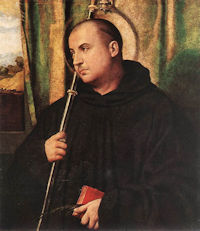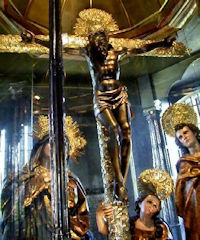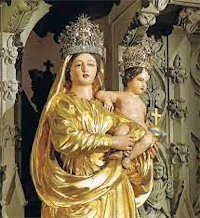Ordinary Time: January 15th
Friday of the First Week in Ordinary Time; Our Lady of Prompt Succor; Black Christ of Esquipulas (Guatemala)
Other Commemorations: St. Maurus, Abbot (RM); Black Christ of Esquipulas (Guatemala)
» Enjoy our Liturgical Seasons series of e-books!
It was from St. Jerome (+ 420) that the west learned of the life of St. Paul the Hermit; the book, which he devoted to the life of the first Christian hermit, charmed and instructed generations of the faithful and formed the inspiration of many artists. St. Paul is said to have died in 341, in a hermitage in the region of Thebes in Egypt after having received at the age of 113 a visit from St. Antony. According to the 1962 Missal of St. John XXIII the Extraordinary Form of the Roman Rite, St. Paul is celebrated as a Confessor, III class and St. Maurus is commemorated.
St. Maurus was one of the first disciples of St. Benedict. In this son of a patrician Roman family, entrusted by his parents to the father of western monasticism, Benedictine tradition celebrates the perfect monk, and the model of childlike obedience. Many monasteries, particularly in France, adopted him as patron. He died about A.D. 580.
In some places in the United States today the feast of Our Lady of Prompt Succor, Patroness of the State of Louisiana, is celebrated.
The feast of the Black Christ of Esquipulas (Santo Cristo de Esquipulas) appears in Appendix I of the U.S. edition of the Misal Romano, Tercera Edicion (2018). Respecting the liturgical norms, this feast may be celebrated for pastoral reasons whnever Votive Masses are permitted.
St. Maurus
 In Benedictine history Maurus holds a distinguished place, taught and trained by St. Benedict himself. While still very young, Maurus and another youth, Placid, were brought by their parents to be reared in monastic life by the Patriarch of Monks. An incident reveals Maurus' spirit of childlike obedience. One day Placid was sent to a near-by lake to draw water. Soon he was at the shore, where, boy that he was, he fell victim to his own heedlessness. Eager to fill the vessel quickly, he reached out too far and was dragged in by the rapidly filling jar. He was being borne along by the waves when from his cell St. Benedict realized what had happened. "Hurry, run to the lake! Placid has fallen in!" he called to Maurus. Stopping only for his spiritual father's blessing, Maurus sped to the lake, seized Placid by the hair and brought him ashore.
In Benedictine history Maurus holds a distinguished place, taught and trained by St. Benedict himself. While still very young, Maurus and another youth, Placid, were brought by their parents to be reared in monastic life by the Patriarch of Monks. An incident reveals Maurus' spirit of childlike obedience. One day Placid was sent to a near-by lake to draw water. Soon he was at the shore, where, boy that he was, he fell victim to his own heedlessness. Eager to fill the vessel quickly, he reached out too far and was dragged in by the rapidly filling jar. He was being borne along by the waves when from his cell St. Benedict realized what had happened. "Hurry, run to the lake! Placid has fallen in!" he called to Maurus. Stopping only for his spiritual father's blessing, Maurus sped to the lake, seized Placid by the hair and brought him ashore.
Imagine his shock and amazement when he realized that he had run some distance on water! His explanation? Such a miracle could not have happened save by virtue of his master's command! St. Gregory relates the incident in his Second Book of Dialogues along with much other interesting detail from the life of St. Benedict. The Martyrology makes this comment on the miracle: How greatly he advanced in faith under his teacher (St. Benedict) is attested by an occurrence unheard of since the days of St. Peter; for, on one occasion he walked upon water as though it were dry land. The tradition that Maurus later became abbot at Glanfeuil in France lacks historical support.
Patronage: against cold; against colds; against goiter; against gout; against hoarseness; against rheumatism; candle makers; charcoal burners; cobblers; coppersmiths; lantern makers; porters; shoemakers; lifeguards; tailors; tinkers; Azores; Badajoz, Spain; Saint-Bonnet-de-Vieille-Vigne, France; Aci Castello, Italy; Casoria, Italy; Castelnuovo Parano, Italy; Cesena, Italy; Monte Cassino Abbey; diocese of Susa
Symbols and Representation: Monk saving Saint Placid from drowning while a cowl floats above him; abbot with crozier; abbot with book and censer; holding the weights and measures of food and drink given him by Saint Benedict
Highlights and Things To Do:
- Read more about St. Maurus:
Black Christ of Esquipulas
 The statue of the Black Christ (El Cristo Negro) was commissioned by Spanish conquistadors for a church in Esquipulas. It was carved in 1594 by Quirio Cataño in Antigua and installed in the church in 1595. By 1603, a miracle had already been attributed to the icon, and it attracted increasing numbers of pilgrims over the years.
The statue of the Black Christ (El Cristo Negro) was commissioned by Spanish conquistadors for a church in Esquipulas. It was carved in 1594 by Quirio Cataño in Antigua and installed in the church in 1595. By 1603, a miracle had already been attributed to the icon, and it attracted increasing numbers of pilgrims over the years.
The history of the Basilica begins in 1735, when a priest named Father Pedro Pardo de Figueroa experienced a miraculous cure after praying before the statue. When he became Archbishop of Guatemala, he commissioned a beautiful basilica to properly shelter the beloved statue. The church was completed in 1759.
The main church, which the Vatican upgraded to the category of Basilica in 1968, is the home of the “Cristo Negro de Esquipulas” or “Black Christ of Esquipulas,” in English. It is one of the most popular images of the Catholic faith, because of the many miracles attributed to it, devotees all over the country pray to the Black Christ for personal petitions.
The sculpture of the Black Christ dates back to 1595 and is made of cedar wood. It was commissioned by Spanish conquistadors for a church in Esquipulas. It was carved in 1594 by Quirio Cataño in Antigua and installed in the church in 1595. It inspires one of the most important Catholic pilgrimages, topped only by the Virgin of Guadeloupe in Mexico. Quirio Cataño sculpted the dramatic art piece in March 9, 1595. Nine years later, in 1603, it had already performed at least one miracle. In 1736, the Bishop of Guatemala XV and first metropolitan Archbishop Fray Pedro Pardo de Figueroa began the process of the construction of a grand Baroque temple to house the Santo Cristo de Esquipulas. On November 4, 1758, the church was inaugurated, that now shelters the venerated image . The Basilica Esquipulas is the second most important religious site in the Americas, after the Virgin of Guadeloupe in Mexico.
Highlights and Things to Do:
- Sisters of Charity provide an image and info
- See Wikipedia for more info.






